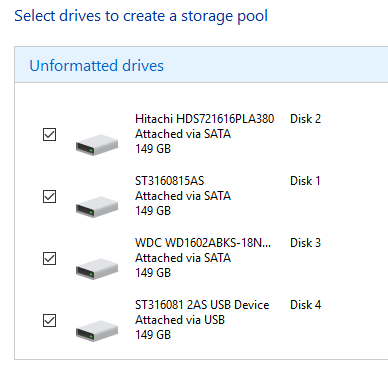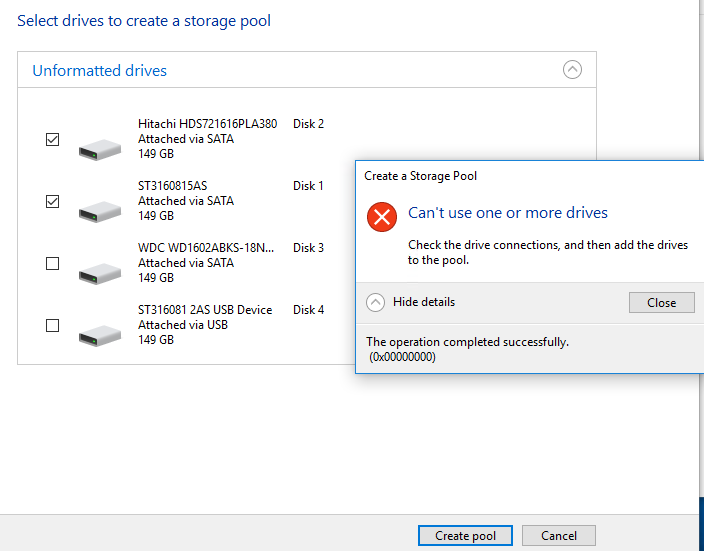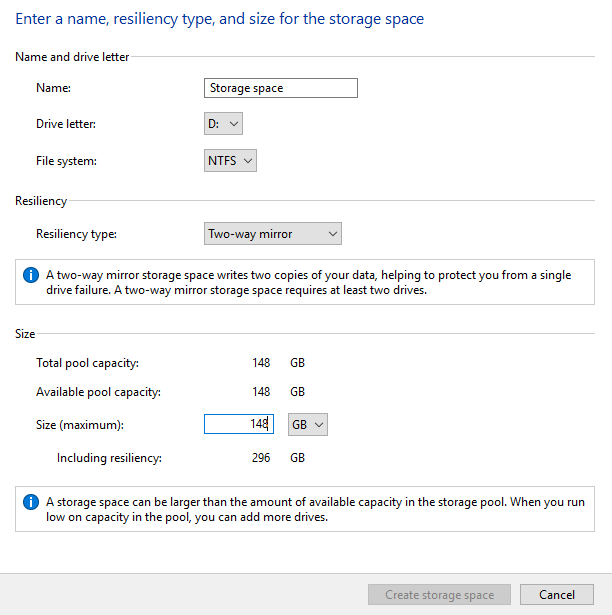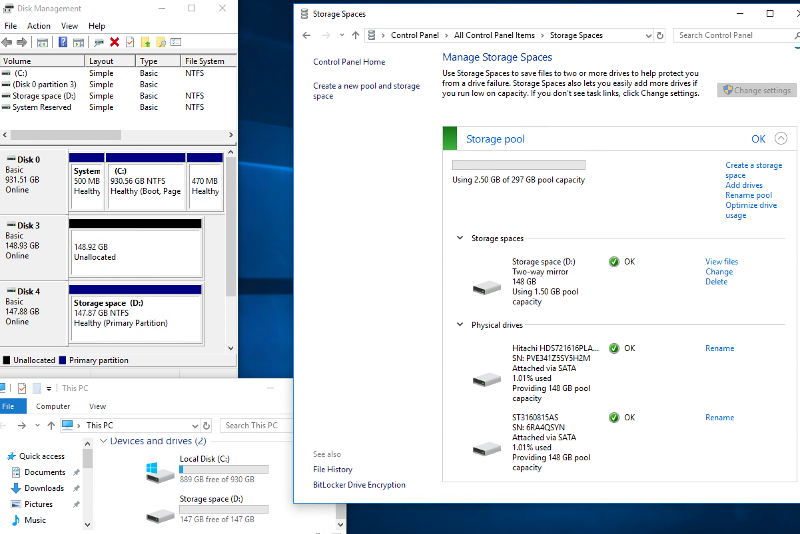sglee
asked on
Creating RAID 10 using Windows 10 Storage Space and Disk Management
Hi,
I have a Windows 10 computer and like to create RAID 10 using both "Storage Spaces" and Disk Management. Currently I have 4 x 160GB SATA HDs (3 HDs connected to SATA ports on MB and 1 HD is connected to external USB Hard Drive duplicator). All four HDs showed up in "My Computer". I deleted existing volumes on each HD in DiskMgmt.msc.
I tried to group these four hard drives in different combinations (all 4 HDs, only 1st and 2nd HDs, 3rd and 4th HDs), but it does not work. I ran Seatools and all HDs have passed the test.
Please look at the screenshots and you will see that "Create Storage space" button is recessed.


Can you tell me how I can create RAID 10 array so that I have a one drive letter with total space of 320GB?
Thanks
I have a Windows 10 computer and like to create RAID 10 using both "Storage Spaces" and Disk Management. Currently I have 4 x 160GB SATA HDs (3 HDs connected to SATA ports on MB and 1 HD is connected to external USB Hard Drive duplicator). All four HDs showed up in "My Computer". I deleted existing volumes on each HD in DiskMgmt.msc.
I tried to group these four hard drives in different combinations (all 4 HDs, only 1st and 2nd HDs, 3rd and 4th HDs), but it does not work. I ran Seatools and all HDs have passed the test.
Please look at the screenshots and you will see that "Create Storage space" button is recessed.
Can you tell me how I can create RAID 10 array so that I have a one drive letter with total space of 320GB?
Thanks
SOLUTION
membership
This solution is only available to members.
To access this solution, you must be a member of Experts Exchange.
Why would you like to use both StSp and software RAID? Why not just Software RAID10?
ASKER
@McKnife,
I didn't think it would be possible to create software RAID 10 using Windows Disk Management.
I didn't think it would be possible to create software RAID 10 using Windows Disk Management.
A, on win10... not on a server... let's see, since Raid 1 is possible and as well Raid 0, 10 could be possible as well - would have to look it up or try it out ->google it.
ASKER
@Cliff
I decided to work with three internal 160GB for now (I wanted to exclude two external hard drives on USB HD duplicator dock for now).
I selected all three in Storage Spaces and created a pool and here is the result: So out of three 160GB HD, I have D drive (with 147GB usable space). What kind of fault tolerance does this give me?
So out of three 160GB HD, I have D drive (with 147GB usable space). What kind of fault tolerance does this give me?
In Disk management, I see "Disk 4 D: 147GB Healthy" and I understand. But "Disk 3, unallocated", what is this for?
I decided to work with three internal 160GB for now (I wanted to exclude two external hard drives on USB HD duplicator dock for now).
I selected all three in Storage Spaces and created a pool and here is the result:
In Disk management, I see "Disk 4 D: 147GB Healthy" and I understand. But "Disk 3, unallocated", what is this for?
SOLUTION
membership
This solution is only available to members.
To access this solution, you must be a member of Experts Exchange.
ASKER
As you've configured it, your storage space is *ROUGHLY* equivalent to RAID 1, yes. I must stress again that storage spaces is *NOT* comparable to RAID. Both can offer fault tolerance, but do so in *very* different ways. Thinking of it as RAID 1 (or RAID 5 or RAID 10) is a good way to get in trouble. I'd recommend losing that terminology.
ASKER
What is advantage of creating a storage space of 148GB of space using storage spaces in Control panel vs going to DiskMgmt.msc, change disk to Dynamic and create RAID 1?
Why would people use storage space?
Why would people use storage space?
One is attached via USB .. that won't work, no matter what software stack you use.
Also looks like you are probably mixing 4K and 512b sectoring. So even if you cracked open the USB and direct connected, you'd still be screwed.
Also looks like you are probably mixing 4K and 512b sectoring. So even if you cracked open the USB and direct connected, you'd still be screwed.
ASKER
@David,
"One is attached via USB .. that won't work, " ---> Yes. I tried that and won't work.
"One is attached via USB .. that won't work, " ---> Yes. I tried that and won't work.
Storage spaces is easier to expand, supports more modern configurations, is better performing, is more resilient.... Many reasons.
ASKER
@Cliff
Can you provide some examples as to why storage space is better than traditional raid system?
Can you provide some examples as to why storage space is better than traditional raid system?
Sure. You can expand storage simply by adding disks to the pool. Many RAID cards cannot do this. Nor dynamic disks easily. You can get redundancy with three disks and benefit from all three. RAID 1 is only 2 disks. RAID 10 requires 4. There is no good mirrored RAID solution that can work with three disks...whuch illustrates my previous point about more flexible options. You can use disks of different sizes. Because of how storage spaces distributes data across disks, rebuilding a failed disk is usually much faster than a comparable RAID failure. That's just off the top of my head. And why I say comparing RAID to storage spaces is apples and oranges.
Ok, let me just add: no, you cannot use disk management in win10 to create a software raid 10, this is for servers, only. What you could do, is create 2 storage spaces made from 2 disks and delete their volumes in diskmgmt, and afterwards create a stripeset out of those, leaving you with a single drive letter, 320 GBs of space and you may lose one disk of each storage space and it will still work. Is this equivalent to Raid10? Who cares. Why stick to names, see if this matches what you want performance-wise and reliability-wise.
Would I want to use that what you have as Raid 10? No. Raid 10 is a good combination of speed and redundancy, often used for database servers, but not at home. Not with these old disks and also not in software but using a hardware raid controller.
What was the idea of using such old, small and slow disks? Is it just for testing?
Would I want to use that what you have as Raid 10? No. Raid 10 is a good combination of speed and redundancy, often used for database servers, but not at home. Not with these old disks and also not in software but using a hardware raid controller.
What was the idea of using such old, small and slow disks? Is it just for testing?
ASKER
@McKnife
"create 2 storage spaces made from 2 disks and delete their volumes in diskmgmt, and afterwards create a stripeset out of those, leaving you with a single drive letter,... Is this equivalent to Raid10? " --> Thank you for the info. I will try that once I get an internal SATA card to connect 4 additional HDs on the stop of OS HD. Currently my test PC has only 4 SATA ports on the MB.
"What was the idea of using such old, small and slow disks?"--> Yes this is just for testing to learn how I can accomplish my goal of setting up a new computer with qty. 4 of 2TB SSDs to provide one contiguous 4TB of space. To me, it was simple - do a RAID 10 using 4 SSDs. But not until I learned that RAID controllers do not support TRIM function that is very important factor in determining the life of SSD. An EE expert said Storage Space supports TRIM function, but I was not sure how to do that. But I think you just explained how to do it - "reate 2 storage spaces ... leaving you with a single drive letter".
Before ordering a new computer and 4 2TB SSD HDs, I just wanted to see for my self how I can do that first.
"create 2 storage spaces made from 2 disks and delete their volumes in diskmgmt, and afterwards create a stripeset out of those, leaving you with a single drive letter,... Is this equivalent to Raid10? " --> Thank you for the info. I will try that once I get an internal SATA card to connect 4 additional HDs on the stop of OS HD. Currently my test PC has only 4 SATA ports on the MB.
"What was the idea of using such old, small and slow disks?"--> Yes this is just for testing to learn how I can accomplish my goal of setting up a new computer with qty. 4 of 2TB SSDs to provide one contiguous 4TB of space. To me, it was simple - do a RAID 10 using 4 SSDs. But not until I learned that RAID controllers do not support TRIM function that is very important factor in determining the life of SSD. An EE expert said Storage Space supports TRIM function, but I was not sure how to do that. But I think you just explained how to do it - "reate 2 storage spaces ... leaving you with a single drive letter".
Before ordering a new computer and 4 2TB SSD HDs, I just wanted to see for my self how I can do that first.
ASKER CERTIFIED SOLUTION
membership
This solution is only available to members.
To access this solution, you must be a member of Experts Exchange.
For the record, I cannot see any benefit of creating a stripe set from two different storage spaces cs just putting all four disks into one larger storage space. The former is laying technologies that were never designed to be used together and makes. troubleshootinf more difficult. The latter is a single pane of glass as is a clean solution.
Just because you can do something doesn't always mean you should.
Just because you can do something doesn't always mean you should.
ASKER
@Cliff
"The latter is a single pane of glass as is a clean solution." --> Can you elaborate on it?
"The latter is a single pane of glass as is a clean solution." --> Can you elaborate on it?
Right so, but since any storage space that would allow the failure of two disks would require at least 5 disks in total, while combining these technologies as described does allow that with 4 disks (which happens to be the amount that he had in mind for testing), I thought it should be mentioned.
I would not recommend combining. I would use hardware raid.
I would not recommend combining. I would use hardware raid.
ASKER
One thing that is nice about "storage space", I learned from EE experts, is that you can simply add additional hard drive to the pool without re-constructing anything. In RAID system, say you created RAID 10 using 4 HDs. If you run out of space and add two more HDs, you have to backup everything and re-create new RAID 10 using 6 HDs.
If that is the case and if there is no difference (betw RAID and storage space) in terms of performance and it provides TRIM function, then I think I rather like to try storage space.
I can get two 500GB SSDs (RAID 1 using on-board RAID controller) just for OS and programs and create a 4TB partition (using 4 x 2TB SSDs) using storage space and store data there.
If that is the case and if there is no difference (betw RAID and storage space) in terms of performance and it provides TRIM function, then I think I rather like to try storage space.
I can get two 500GB SSDs (RAID 1 using on-board RAID controller) just for OS and programs and create a 4TB partition (using 4 x 2TB SSDs) using storage space and store data there.
"create a 4TB partition (using 4 x 2TB SSDs) using storage space and store data there." - yes, great, but still this means only protection against the failure of 1 drive at a time, while Raid10 with 4 drives would withstand 2 failing drives (although not two on the same mirrored stripeset of course).
As for flexibility, storage spaces is great, no doubt.
As for flexibility, storage spaces is great, no doubt.
Yeah, RAID10 can handle "up to" 2 drive failures, but it has to be the "right" drives. I wouldn't ever bill it as able to survive two drive failures, as the odds of that are actually not great. In fact, that's another checkbox I put in storage spaces column. With a three-way mirror, you can survive a failure of any two drives (closer in comparison to RAID-6 than anything), but doesn't have the parity performance hit that RAID-6 has. The downside being, of course, that you lost more space since every bit of data is copied twice, and as noted, minimum of five drives.
Still For mission critical data, this is still more resilient and performant than RAID-6. And if it isn't mission critical, storage spaces offers parity solutions for archiving as well.
@sglee : Not much to elaborate on. You manage your pools and spaces in the window you already took a screenshot of. Everything you need to know about your storage space is there. The health of the pool. The health of the disks. Free space. Single pane of glass. If you did two storage spaces and then did a stripe-set in disk manager, you'd know the health of the individual storage spaces in one pane, but to check on the stripe-set you'd have to do so in disk manager. And if something went wrong, you'd have to figure out WHAT went wrong and that means digging into several different places as it could be wrong in several different technologies. Not a single pane of glass anymore.
It's a neat idea in that steampunk board-game "Mousetrap" elaborate concoction sort of way. But it'd never be something I'd run in production, or even in a valid test lab (I only test lab things I'd eventually run in production.) Based on McKnife's response about never doing it and just going hardware RAID, I don't think he'd disagree. It is maybe doable (I actually am not convinced that you could delete the partitions to stripe without destroying the storage space, but am not motivated to lab it to prove it breaks...) ...but even it is doable, I don't consider it practical.
Full disclosure : I am a big storage spaces advocate. For me, RAID is dead. I can't justify the higher cost and proprietary lock-in that RAID brings, when storage spaces does everything I'd want RAID to do and more. I suppose there are edge cases where RAID makes sense in large SANs or in datacenters, but edge cases are exactly that...edge cases. By and large, I think storage spaces is a smarter investment for 90% of the SMB market and smaller enterprise market.
Still For mission critical data, this is still more resilient and performant than RAID-6. And if it isn't mission critical, storage spaces offers parity solutions for archiving as well.
@sglee : Not much to elaborate on. You manage your pools and spaces in the window you already took a screenshot of. Everything you need to know about your storage space is there. The health of the pool. The health of the disks. Free space. Single pane of glass. If you did two storage spaces and then did a stripe-set in disk manager, you'd know the health of the individual storage spaces in one pane, but to check on the stripe-set you'd have to do so in disk manager. And if something went wrong, you'd have to figure out WHAT went wrong and that means digging into several different places as it could be wrong in several different technologies. Not a single pane of glass anymore.
It's a neat idea in that steampunk board-game "Mousetrap" elaborate concoction sort of way. But it'd never be something I'd run in production, or even in a valid test lab (I only test lab things I'd eventually run in production.) Based on McKnife's response about never doing it and just going hardware RAID, I don't think he'd disagree. It is maybe doable (I actually am not convinced that you could delete the partitions to stripe without destroying the storage space, but am not motivated to lab it to prove it breaks...) ...but even it is doable, I don't consider it practical.
Full disclosure : I am a big storage spaces advocate. For me, RAID is dead. I can't justify the higher cost and proprietary lock-in that RAID brings, when storage spaces does everything I'd want RAID to do and more. I suppose there are edge cases where RAID makes sense in large SANs or in datacenters, but edge cases are exactly that...edge cases. By and large, I think storage spaces is a smarter investment for 90% of the SMB market and smaller enterprise market.
It's doable (tested in hyper-v), but no, I'd never recommend combining those.
If I were sglee, I would ask myself if performance matters at all and if it does, ask myself how much it matters and then read comparisons of storage spaces performance against hw raid done on the same controller (seen some reports).
If it's more about flexibility, go with storage spaces.
If I were sglee, I would ask myself if performance matters at all and if it does, ask myself how much it matters and then read comparisons of storage spaces performance against hw raid done on the same controller (seen some reports).
If it's more about flexibility, go with storage spaces.
ASKER
Thank you for your insight. Instead of using Storage Space/Disk Management, I have decided to go with RAID 10 using on-board RAID controller using qty. 4 of 4TB SSDs. If I don't have worry about TRIM per McKnife, I think setting up RAID 10 is simpler solution and easier to maintain.